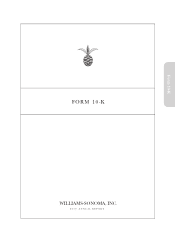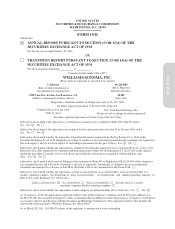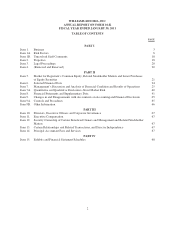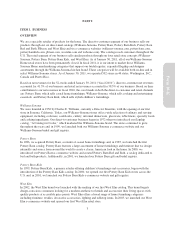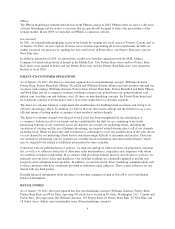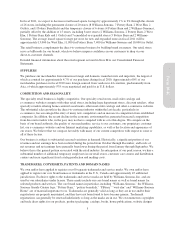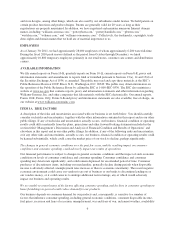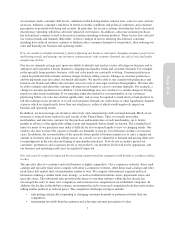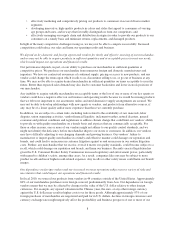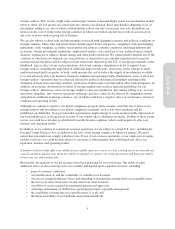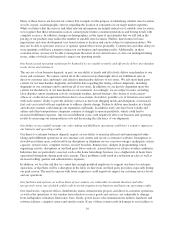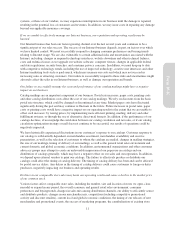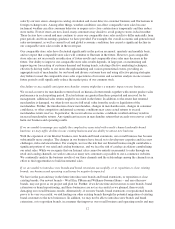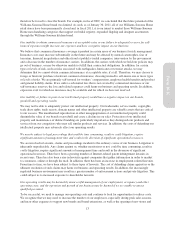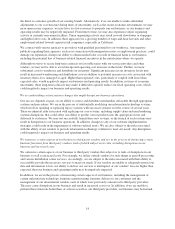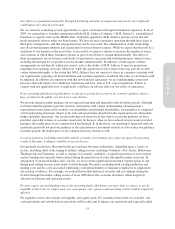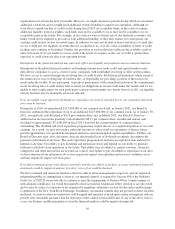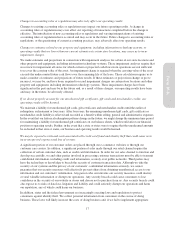Pottery Barn 2010 Annual Report Download - page 21
Download and view the complete annual report
Please find page 21 of the 2010 Pottery Barn annual report below. You can navigate through the pages in the report by either clicking on the pages listed below, or by using the keyword search tool below to find specific information within the annual report.
of consumer credit, consumer debt levels, conditions in the housing market, interest rates, sales tax rates and rate
increases, inflation, consumer confidence in future economic conditions and political conditions, and consumer
perceptions of personal well-being and security. In particular, the recent economic downturn has led to decreased
discretionary spending, which has adversely impacted our business. In addition, a decrease in home purchases
has led and may continue to lead to decreased consumer spending on home products. These factors have affected
our various brands and channels differently. Adverse changes in factors affecting discretionary consumer
spending have reduced and may continue to further reduce consumer demand for our products, thus reducing our
sales and harming our business and operating results.
If we are unable to identify and analyze factors affecting our business, anticipate changing consumer preferences
and buying trends, and manage our inventory commensurate with customer demand, our sales levels and profit
margin may decline.
Our success depends, in large part, upon our ability to identify and analyze factors affecting our business and to
anticipate and respond in a timely manner to changing merchandise trends and customer demands. For example,
in the specialty home products business, style and color trends are constantly evolving. Consumer preferences
cannot be predicted with certainty and may change between selling seasons. Changes in customer preferences
and buying trends may also affect our brands differently. We must be able to stay current with preferences and
trends in our brands and address the customer tastes for each of our target customer demographics. We must also
be able to identify and adjust the customer offerings in our brands to cater to customer demands. For example, a
change in customer preferences for children’s room furnishings may not correlate to a similar change in buying
trends for other home furnishings. If we misjudge either the market for our merchandise or our customers’
purchasing habits, our sales may decline significantly, and we may be required to mark down certain products to
sell the resulting excess inventory or to sell such inventory through our outlet stores or other liquidation channels
at prices which are significantly lower than our retail prices, either of which would negatively impact our
business and operating results.
In addition, we must manage our inventory effectively and commensurate with customer demand. Much of our
inventory is sourced from vendors located outside of the United States. Thus, we usually must order
merchandise, and enter into contracts for the purchase and manufacture of such merchandise, up to twelve
months in advance of the applicable selling season and frequently before trends are known. The extended lead
times for many of our purchases may make it difficult for us to respond rapidly to new or changing trends. Our
vendors also may not have the capacity to handle our demands or may go out of business in times of economic
crisis. In addition, the seasonal nature of the specialty home products business requires us to carry a significant
amount of inventory prior to peak selling season. As a result, we are vulnerable to demand and pricing shifts and
to misjudgments in the selection and timing of merchandise purchases. If we do not accurately predict our
customers’ preferences and acceptance levels of our products, our inventory levels will not be appropriate, and
our business and operating results may be negatively impacted.
Our sales may be negatively impacted by increasing competition from companies with brands or products similar
to ours.
The specialty direct-to-customer and retail business is highly competitive. Our e-commerce websites, direct mail
catalogs and specialty retail stores compete with other e-commerce websites, other direct mail catalogs and other
retail stores that market lines of merchandise similar to ours. We compete with national, regional and local
businesses utilizing a similar retail store strategy, as well as traditional furniture stores, department stores and
specialty stores. The substantial sales growth in the direct-to-customer industry within the last decade has
encouraged the entry of many new competitors and an increase in competition from established companies. In
addition, the decline in the global economic environment has led to increased competition from discount retailers
selling similar products at reduced prices. The competitive challenges facing us include:
• anticipating and quickly responding to changing consumer demands or preferences better than our
competitors;
• maintaining favorable brand recognition and achieving customer perception of value;
7
Form 10-K


